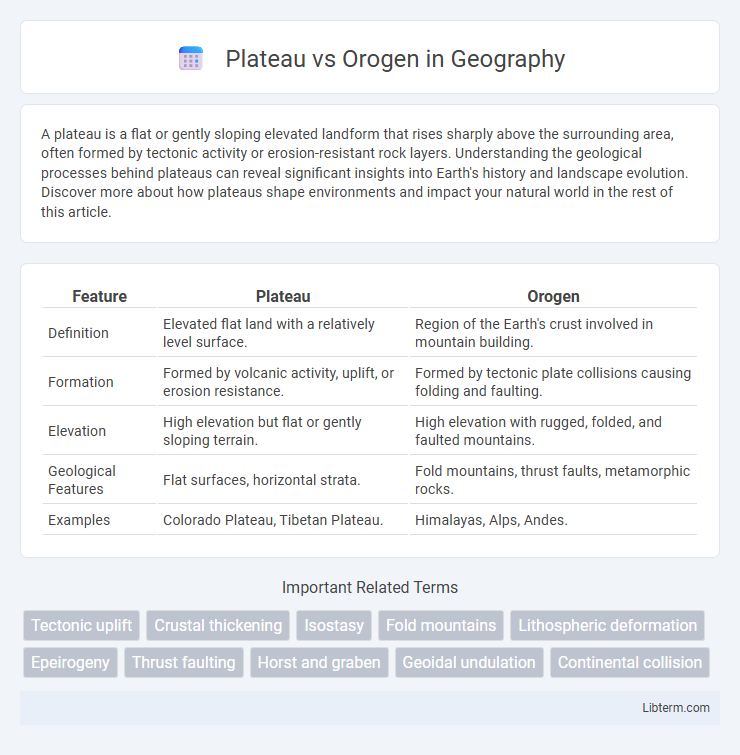A plateau is a flat or gently sloping elevated landform that rises sharply above the surrounding area, often formed by tectonic activity or erosion-resistant rock layers. Understanding the geological processes behind plateaus can reveal significant insights into Earth's history and landscape evolution. Discover more about how plateaus shape environments and impact your natural world in the rest of this article.
Table of Comparison
| Feature | Plateau | Orogen |
|---|---|---|
| Definition | Elevated flat land with a relatively level surface. | Region of the Earth's crust involved in mountain building. |
| Formation | Formed by volcanic activity, uplift, or erosion resistance. | Formed by tectonic plate collisions causing folding and faulting. |
| Elevation | High elevation but flat or gently sloping terrain. | High elevation with rugged, folded, and faulted mountains. |
| Geological Features | Flat surfaces, horizontal strata. | Fold mountains, thrust faults, metamorphic rocks. |
| Examples | Colorado Plateau, Tibetan Plateau. | Himalayas, Alps, Andes. |
Introduction to Plateaus and Orogens
Plateaus are elevated flat or gently undulating landforms formed by tectonic uplift or volcanic activity, often characterized by extensive horizontal rock layers. Orogens refer to mountain-building regions created through compressional tectonics, involving the folding, faulting, and metamorphism of Earth's crust. Understanding the distinction between plateaus and orogens highlights the contrast between broad, stable uplifted surfaces and intensely deformed mountain belts in geological processes.
Geological Definitions: Plateau vs Orogen
A plateau is a flat or gently undulating elevated landform that rises sharply above the surrounding area, often formed through tectonic uplift or volcanic activity and characterized by relatively stable geological structures. An orogen, or orogenic belt, refers to a region of the Earth's crust subjected to intense deformation, metamorphism, and mountain-building processes driven by plate tectonic collisions, resulting in folded, faulted, and uplifted rocks. These geological definitions highlight that plateaus represent broad, elevated terrains with minimal deformation, whereas orogens are dynamic zones of crustal thickening and complex structural geology associated with mountain formation.
Formation Processes of Plateaus
Plateaus form primarily through tectonic uplift, volcanic activity, or sediment accumulation that elevates large, flat regions above the surrounding terrain. Unlike orogens, which result from the intense folding, faulting, and deformation of Earth's crust during mountain-building processes, plateaus experience more uniform vertical uplift with less crustal deformation. Common examples include the Colorado Plateau formed by lithospheric uplift and the Deccan Plateau shaped by extensive volcanic lava flows.
Orogeny: The Birth of Mountain Belts
Orogeny refers to the geological process responsible for the formation of mountain belts through tectonic plate interactions such as collision, subduction, and continental convergence. This intense deformation and folding of the Earth's crust result in uplifted mountainous regions contrasting with the flat, elevated landforms characteristic of plateaus. Understanding orogenic mechanisms is crucial for studying Earth's topographic evolution and associated seismic activity.
Key Physical Characteristics
Plateaus are extensive flat or gently undulating elevated regions typically rising sharply above surrounding areas, characterized by relatively uniform elevation and minimal deformation. Orogens, or mountain belts, display highly deformed, folded, and faulted rocks resulting from tectonic plate collisions, featuring sharp elevation changes and rugged topography. Key differences include the plateau's broad, stable surfaces versus the orogen's complex structural geology and intense uplift.
Major Examples Around the World
Plateaus such as the Tibetan Plateau, the Deccan Plateau in India, and the Colorado Plateau in the United States represent extensive elevated flatlands formed mainly through tectonic uplift or volcanic activity. Orogens, including the Himalayas, the Andes, and the Alps, are mountain ranges created by the collision and folding of Earth's lithospheric plates during orogenic events. These geological structures distinguish themselves by their formation processes, with plateaus exhibiting broad, level terrain and orogens displaying rugged, elevated peaks.
Ecological and Climatic Differences
Plateaus, characterized by elevated flat terrains, often support distinct ecosystems with sparse vegetation due to limited soil depth and moderate rainfall, resulting in relatively stable climatic conditions. Orogens, or mountain ranges formed by tectonic plate collisions, present diverse microclimates and rich biodiversity driven by altitude variations, increased precipitation, and rugged landscapes. The ecological contrast between plateaus and orogens highlights differences in species adaptation, habitat complexity, and weather patterns closely tied to their geomorphological features.
Human Impact and Utilization
Plateaus, with their flat, elevated terrain, are often utilized for agriculture, urban development, and mining due to their stable landforms and accessibility. Orogens, characterized by folded and faulted mountain ranges, offer rich mineral resources but present challenges for large-scale human settlement and infrastructure development because of their rugged terrain. Human impact on plateaus includes soil erosion and deforestation, while orogenic regions face risks like landslides and habitat fragmentation from mining and road construction.
Comparative Geological Significance
Plateaus and orogens represent distinct geological structures with critical relevance to Earth's tectonic processes. Plateaus, characterized by relatively flat elevated terrains often formed by volcanic activity or crustal uplift, contrast with orogens, which are mountain belts created primarily through tectonic plate collisions and crustal deformation. Understanding the comparative geological significance of plateaus and orogens reveals insights into Earth's crustal dynamics, sedimentation patterns, and seismic activity distributions crucial for geoscientific research and resource exploration.
Conclusion: Plateau vs Orogen in Earth’s Evolution
Plateaus and orogens represent distinct geological features formed through different tectonic processes, with plateaus primarily resulting from crustal uplift and orogens from mountain-building via plate collision. Both play crucial roles in Earth's evolution by shaping topography, influencing climate patterns, and driving erosion and sedimentation cycles. Understanding the interplay between plateaus and orogens elucidates the dynamic processes of crustal deformation and landscape development over geological time.
Plateau Infographic

 libterm.com
libterm.com